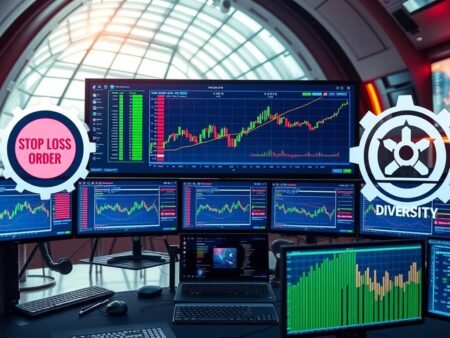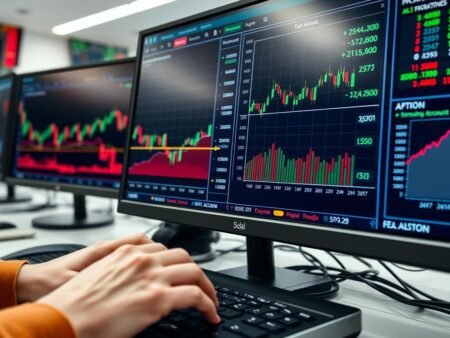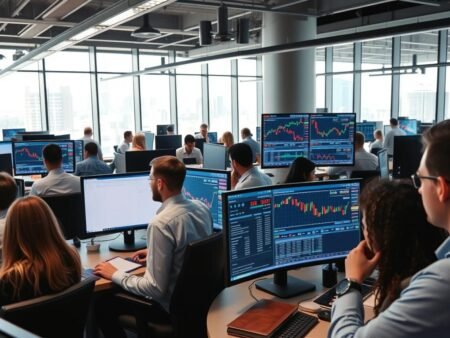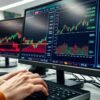In the fast-paced world of trading, every millisecond counts. Could your trading strategies be missing something crucial? If you’re a trader in a proprietary firm, are you using automated trading software to its fullest? This guide delves into the world of automated trading systems, a tool that could change the game for prop traders.
Automated trading systems are changing the game for prop firms. They make it possible to execute complex strategies quickly and efficiently. But, can prop firms really use these systems? This question is filled with promise and risk, and we’re here to help you understand both sides.
By using automated trading systems, prop firms can explore new financial strategies. But, it’s important to understand how these systems work, their benefits, and how they fit with your firm’s setup. This balance is key to unlocking their potential while staying compliant.
Key Takeaways
- Enhanced understanding of how automated trading software can fit within the dynamic environment of prop firms.
- Insight into legal and firm policy considerations when deploying automated trading systems.
- Assessment of the impact and evolution of algorithmic trading in the realm of proprietary trading.
- A comprehensive checklist for selecting the right automated trading tools tailored to prop firm needs.
- The significance of regulatory compliance and best practices for maintaining ATS in prop trading firms.
Introduction to Automated Trading in Proprietary Trading Firms
In the fast-paced world of finance, prop trading firms are known for their unique approach. They use their own capital, unlike other firms that handle client funds. This setup lets them try new trading methods, like automated trading systems and algorithmic trading.
Algorithmic trading has become more popular in these firms. It can handle huge amounts of data and make trades fast and accurately. This is key in high-frequency trading, where quick decisions are crucial.
Automated trading systems use set strategies and computations to make trades. These systems help prop trading firms succeed in fast-paced markets. They are mainly used in quantitative trading, which looks for market inefficiencies through stats.
The table below shows how algorithmic and automated systems compare to traditional trading in prop firms:
| Feature | Traditional Trading | Automated/Algorithmic Trading |
|---|---|---|
| Speed of Execution | Dependent on human input | High-speed, millisecond execution |
| Error Rate | Higher due to human factors | Lower, as machines follow programmed rules |
| Operational Hours | Limited to trading hours | 24/7 trading capabilities |
| Scope of Data Analysis | Limited by human capability | Extensive, can process large datasets quickly |
The move to algorithmic trading in prop firms shows a bigger trend in finance. It’s all about making things more automated and efficient. But, these changes need skilled people and careful watching to keep things right in the fast-changing trading world.
Can You Use Automated Trading Systems in Prop Firms?
In the fast-changing world of proprietary trading, using automated trading systems is a big topic. It raises questions about legal and policy rules. It’s important to know these before using such systems in a prop firm.
Understanding the Legal Landscape of Automated Trading in Prop Firms
Algorithmic trading platforms in prop firms face strict rules. These rules change a lot from place to place. In the U.S., the SEC and CFTC set rules to keep trading fair and transparent.
These rules help stop unfair market practices. They make sure everyone plays by the same rules. This keeps investors trusting and the markets fair.
Evaluating Firm Policies on Trading Automation
Every prop trading firm has its own rules for using automated trading. These rules try to balance using new tech for better trading and following strict rules. Firms often check their plans and risks before using automated systems.
This makes sure they follow rules and fit with the firm’s goals and risk levels.
Knowing the rules and firm policies is key for using automated trading in prop firms. It’s a careful path that balances new tech with following the law. So, using algorithmic trading platforms needs a deep understanding of rules and firm policies.
The Role of Algorithmic Trading in Modern Prop Firms
The financial world is getting more complex. This has led to a big increase in algorithmic trading in prop firms. It’s a move towards smarter, automated systems that can quickly analyze lots of data to make good trading choices.
This change is making prop trading strategies more advanced. It combines the power of algorithms with the fast-changing nature of markets.
The Evolution of Algorithmic Strategies in Proprietary Trading
Algorithmic trading has changed a lot in recent years. What started as simple rules now uses complex machine learning to predict market trends. This makes trades more accurate and helps in planning strategies for prop firms.
Comparing Human Traders and Algorithmic Trading Systems
The argument between human traders and algorithms is ongoing. Humans are great at making quick decisions in unexpected situations. But algorithms can process data faster and make trades more accurately than humans.
In summary, algorithmic trading is key in modern prop trading. It combines human skills with advanced systems. This creates a competitive and innovative environment in prop firms.
Benefits of Implementing Trading Automation in Prop Firms
Prop trading firms that use trading automation see big improvements. They get faster and better at making money. This is key to keeping up in the fast world of trading.
Trading automation helps firms run complex strategies well and fast. It also cuts down on mistakes. It’s great for handling lots of data and finding good market chances. Plus, it helps manage risks by setting limits and watching how things go.
Let’s look at the main benefits of trading automation for prop trading firms:
- Improved Execution Speed: Trades happen quicker than with manual methods. This is important in markets where prices change fast.
- Consistency and Precision: Automated trading takes out emotions, making trades consistent and precise.
- Sophisticated Risk Management: Automated systems adjust quickly to market changes. This helps keep risks under control.
- Increase in Profitability: Better efficiency and accuracy in trading can lead to more profits.
The table below shows how trading automation has helped some top prop trading firms:
| Prop Trading Firm | Profit Margin Pre-Automation (%) | Profit Margin Post-Automation (%) | |
|---|---|---|---|
| Example Firm 1 | 15 | 25 | |
| Example Firm 2 | 10 | 20 | |
| Example Firm 3 | 20 | 30 |
In summary, trading automation boosts strategy execution and profits for prop trading firms. As markets change, using advanced automated systems is crucial for firms to stay strong and grow.
Developing Proprietary Automated Trading Strategies
The world of proprietary trading has changed a lot with trading automation. Making unique prop trading strategies needs both expert analysis and top-notch automated trading software. It’s not just about using existing solutions. It’s about making special algorithms that fit a firm’s exact needs and views.
Quantitative analysts and software developers are key in this process. They use their skills to make complex trading automation algorithms. These algorithms help firms stay ahead in the fast trading world.
- They can quickly analyze and react to market changes.
- They can adjust to new information and improve their strategies.
- They have backtesting tools in the automated trading software to test their strength before use.
With the right automated trading software, firms can make their strategies unique. They can also control their trading better, which can really help their success.
This table shows the main differences between generic and proprietary automated trading strategies:
| Generic Automated Strategies | Proprietary Automated Strategies | |
|---|---|---|
| Approach | One-size-fits-all | Custom-tailored to specific market insights |
| Flexibility | Low | High – adaptable to firm-specific needs |
| Performance in Volatile Markets | Often less effective | Designed to capitalize on market volatilities |
| Competitive Advantage | Limited | Significant – unique strategies hidden from competitors |
In conclusion, for proprietary trading firms, making special prop trading strategies with trading automation is crucial. These strategies improve trading and keep the firm competitive in today’s fast markets.
Criteria for Choosing Automated Trading Software
Choosing the right automated trading software is key for success in proprietary trading. There are many tools and platforms out there. It’s vital to focus on features and compatibility that meet your firm’s needs.
Feature Checklist for Selecting the Right Trading Automation Tools
When looking at automated trading software, keep these key features in mind:
- Reliability and Speed: The software should trade quickly and reliably, no matter the market.
- User Interface (UI): A user-friendly UI helps all traders work efficiently.
- Customizability: Being able to tweak algorithms and automate strategies is crucial.
- Backtesting Capabilities: Tools for testing strategies against past data are essential.
- Security Features: Strong security is needed to protect data and trade information.
- Support and Updates: Ongoing support and updates help keep up with market changes.
- Integration Options: The software should work well with your current systems and tools.
These features ensure the software boosts your trading activities effectively.
Compatibility with Prop Trading Firm Needs and Infrastructure
It’s important to match the software with your firm’s environment. You need to understand your trading style, goals, and current setup.
| Software Feature | Importance to Prop Firm |
|---|---|
| High-Performance Analytics | Critical for real-time decision making |
| Scalability | Essential for expansion without performance loss |
| Compatibility with Multi-Asset Classes | Important for firms trading across markets |
| Regulatory Compliance Tools | Must-have to adhere to global trade compliance |
| System Robustness | Reduces downtime and increases trustworthiness |
Choosing software that fits your technology and goals can greatly improve performance and profits.
The specific needs of your trading firm should guide your software choice. The right tools can significantly boost your trading results if they align with your goals and systems.
Challenges and Risks Associated with Automated Trading
Automated trading systems change how prop trading strategies are done. But, they come with their own set of challenges and risks. The use of technology can lead to technical failures that affect trading results. Also, keeping the trading automation system running smoothly is a big task that needs constant risk management to avoid losses.
These systems can make traders over-optimize their strategies. This means they fine-tune their plans too much based on past data, but they don’t work well in real-time markets. This can lead to big financial losses, especially in markets that change a lot. So, it’s important for firms to find a balance between the perfect plans of automated systems and the unpredictable nature of financial markets.
- Risk of Overfitting: Strategies that fit past data too well might not work in live markets.
- Technical Faults: Software problems can cause unwanted trades or lose data, affecting trading success.
- Security Risks: Using digital tools a lot makes it easier for cyber-attacks.
It’s key for any firm using automated trading systems to know these risks. They need strong backup systems and a team ready to handle and fix any unexpected problems or security breaches quickly.
| Risk Factor | Description | Mitigation Strategy |
|---|---|---|
| Overfitting | Strategies too tailored to historical data fail in new conditions. | Regular updates and cross-validation with new data. |
| Technical Failures | System malfunctions that may cause unexpected trading behaviors. | Comprehensive testing and quality assurance protocols. |
| Cybersecurity Threats | Potential hacks or unauthorized access that could disrupt trading operations. | Advanced security measures and constant monitoring. |
Using trading automation brings big benefits, but managing risks is just as important. Good risk management is key to getting the most out of automated trading systems. Check out this detailed guide to learn how to use automation wisely and keep investments and operations safe in a professional trading setting.
Regulatory Compliance: Navigating Prop Trading Regulations
Understanding prop trading regulations is key. The financial world changes fast, making compliance and reporting rules more complex. For trading firms, following these rules is crucial for staying legal and profitable.
Avoiding Pitfalls with Automated Systems in Regulated Markets
Compliance begins with knowing what automated trading systems can do. Firms must make sure their algorithms don’t break laws on market manipulation, fraud, or trade reporting. Designing compliance into algorithms early on can lower risks.
Maintaining Compliance with Trade Reporting and Monitoring Tools
Trade reporting is vital for keeping trading activities transparent and accountable. Good monitoring tools are needed to watch automated systems. These tools track trades, helping firms prepare for regulatory checks.
| Feature | Importance for Compliance | Example of Implementation |
|---|---|---|
| Real-Time Monitoring | Essential for immediate issue identification | Systems that alert compliance officers when real-time anomalies or deviations from preset rules occur. |
| Historical Data Analysis | Key for retrospective audits and understanding past transactions | Tools that aggregate and analyze past trading data to uncover patterns that may suggest malpractice. |
| Transaction Reporting Software | Crucial for fulfilling trade reporting requirements | Automated systems that compile and submit trade reports to regulatory bodies without manual intervention. |
To stay ahead, trading firms must keep their compliance strategies up to date. This not only protects them from legal issues but also builds trust in the market.
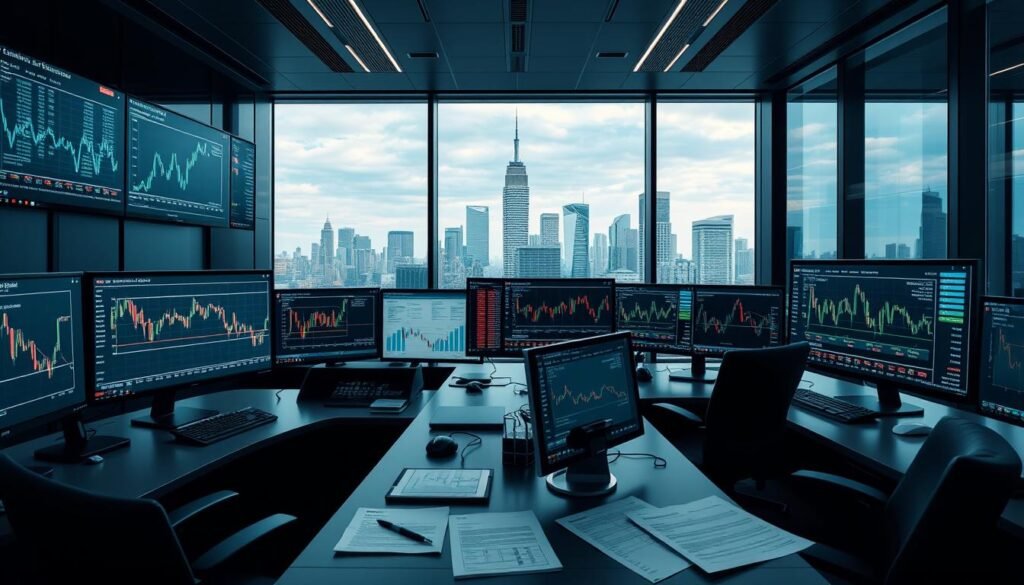
Educational Resources for Prop Trading Automation
For professionals and firms in automated and algorithmic trading, education is key. The world of prop trading strategies and automated trading software is complex. But, a strong educational base can greatly improve your skills. Here’s a list of resources to help you understand and master these areas.
- Online Courses: Many platforms have detailed courses on algorithmic trading. They teach both new and experienced traders how to make and use trading algorithms.
- Webinars: Live sessions offer insights into market trends and software use. They are led by experts in automated trading.
- Books: There are many books covering the basics of automation in trading to advanced prop trading strategies.
- Software Tutorials: Developers of automated trading software provide detailed tutorials. These are essential for learning these tools.
Keeping up with the latest in automation and trading is crucial. It’s not just good; it’s necessary for anyone serious about using automation in proprietary trading. Here’s a table showing some top resources for learning automated trading software and algorithmic trading platforms.
| Resource Type | Title/Provider | Focus Area |
|---|---|---|
| Online Course | Algorithmic Trading & Quantitative Analysis Using Python | Fundamental to Advanced Algorithmic Techniques |
| Webinar | Mastering Prop Trading Strategies | Proprietary Trading Strategies |
| Book | “Automated Trading with R” | Statistical Methods for Automated Trading |
| Software Tutorial | MetaTrader 4 Official Tutorials | Using MT4 for Forex Algorithmic Trading |
Investing in education for automated trading software and algorithmic trading platforms is vital. It not only improves your skills but also helps you stay adaptable and successful in proprietary trading. As the market changes, so should your strategies and tools. The best educational resources can guide you.
Implementing Automated Trading Systems: Step-by-Step Process
Adding automated trading software to prop trading firms is a detailed process. It starts with an idea and ends with real market action. This journey uses trading automation and backtesting to make sure the system works well in real markets.
From Concept to Live Trading: Building Your Automated System
Creating an automated trading system starts with clear goals and strategies. Prop trading firms work with developers to create the first idea. This idea is then turned into code that can trade on its own. This stage is key because it sets the rules for how the system will work.
Backtesting: The Importance of Historical Data Analysis
Backtesting is a critical step in using automated trading systems. It tests the strategies against past market data to see if they work. This step shows if the strategy could make money and helps make it better for different market situations. It also lowers the risk of losing money in real trading.
Here’s a simple overview of the backtesting process:
- Data Collection: Gathering important historical market data.
- Strategy Definition: Writing down and putting the trading strategy into backtesting software.
- Risk Assessment: Looking at possible risks and how much money could be lost in different markets.
- Optimization: Making the strategy better based on backtesting results.
- Validation: A final test to make sure the strategy works well before it’s used in real trading.
| Step | Detail | Importance |
|---|---|---|
| Data Collection | Compile historical data | Foundation for testing |
| Strategy Definition | Code the trading logic | Defines operational behavior |
| Risk Assessment | Evaluate potential risks | Prevents future drawdowns |
| Optimization | Tweak strategy parameters | Enhances profitability |
| Validation | Confirm strategy reliability | Ensures readiness for live trading |
Best Practices for Maintaining Automated Trading Systems in Prop Firms
Keeping automated trading systems running smoothly is key for proprietary trading firms. These systems need constant checks to stay sharp in the fast-paced world of prop trading strategies.
Regular system audits are vital. They spot problems early, keeping the automated trading systems on track. Also, reviewing how well the systems perform is crucial. It checks if they meet their goals and handle market changes well.
Keeping the systems up-to-date is also important. Prop trading strategies change with the market. So, the systems must adapt to stay ahead and make the most money.
- Regular Audits: Routine checks to assess the operational integrity and security measures of the system.
- Performance Reviews: Analyzing trading results periodically to validate the effectiveness of the trading strategies implemented.
- System Updates: Applying upgrades to ensure trading algorithms stay relevant with current market dynamics.
- Infrastructure Checks: Ensuring the hardware and network systems supporting the algorithms are functioning optimally.
Having a strong technical support structure is also essential. This support helps fix problems quickly and prevents downtime. It keeps trading safe and follows market rules.
Keeping automated trading systems and algorithmic trading platforms up-to-date requires a team effort. This includes regular updates, training for tech staff, and being ready to grow with the market. This approach helps prop trading strategies thrive in a competitive world.
Success Stories: Prop Firms That Have Embraced Automation
Automated trading systems have brought big wins to prop trading firms. Real examples show how automation boosts profits and efficiency. It also shows how tech is growing in proprietary trading.
Case Studies of Successful Automation Integration
Prop trading firms use advanced systems to stay ahead. For example, a New York firm saw a 20% jump in yearly earnings. These systems help make quick decisions and cut down on mistakes.
Measurable Improvements in Trading Outcomes Through Automation
Automation has led to clear gains in trading volume, accuracy, and cost savings. It helps firms analyze market trends better. This allows them to make high-frequency trades with great precision.
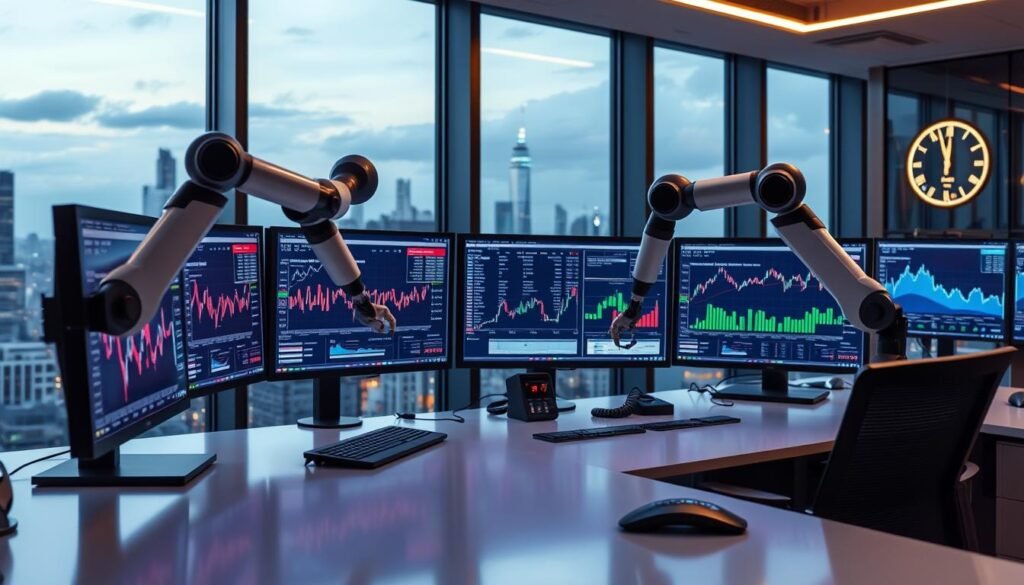
Automation has changed how prop trading firms work. It sets a new standard for success in trading. These systems are also flexible and keep improving, helping firms grow and stay profitable.
Future of Trading Automation in Proprietary Trading
The world of proprietary trading is changing fast, thanks to new tech. The future of trading automation is bringing a new level of efficiency and strategy. Now, automated trading software can handle complex prop trading strategies with great accuracy.
Artificial intelligence (AI) and machine learning (ML) are set to play a big role. They will help systems learn from the market and adjust strategies quickly. This means trading could become even more precise and effective.
AI-driven automation could change the industry a lot. These smart systems will give deeper insights into market trends. They can predict changes with high accuracy, making high-frequency trading even more advanced.
This could also change how markets work. It might make things more fair or create new opportunities for some firms. The key is how well these technologies are used.
As trading automation grows, so will its impact on prop firms. We might see a shift towards faster, more analytical trading. This could make old ways seem slow by comparison.
But there are also challenges ahead. Things like cybersecurity and ethics in trading systems will need careful handling. We’ll need new rules to keep the market safe and fair. The future of trading automation looks very different and exciting.
